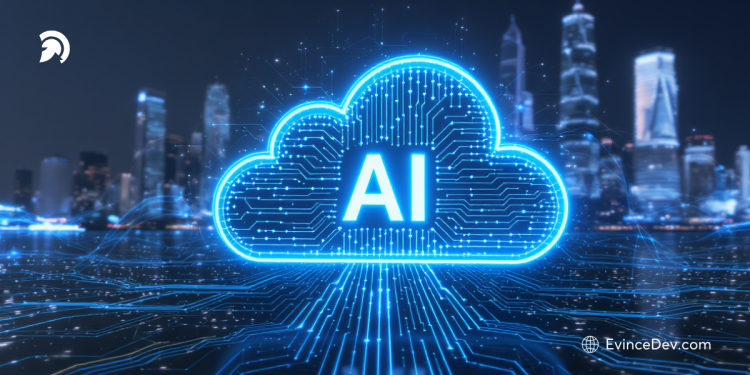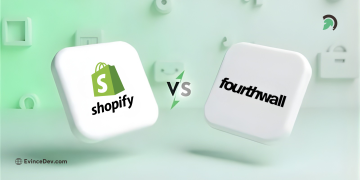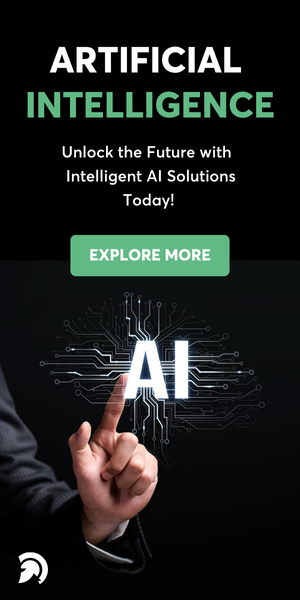Key Takeaways:
- Cloud platforms give generative AI the power to scale models with high efficiency
- AI systems use cloud compute to train faster, reduce costs, and improve outcomes
- Cloud-native AI enables real-time generation of content, insights, and automation
- Scalable cloud storage fuels generative models with massive, accessible datasets
- Together, AI and cloud deliver flexible, reliable intelligence for modern enterprises
In a rapidly evolving digital landscape, organisations are no longer satisfied with simply “getting smart”; they demand intelligence that scales, adapts, and fuels innovation across geographies and operations. At the heart of this transformation lies the merging of two powerful forces: Generative AI and cloud computing.
Generative AI brings creativity, enabling the generation of text, images, code, workflows, or decisions. At the same time, cloud computing delivers the scale, elasticity, global footprint, and infrastructure necessary to deploy intelligence at enterprise-grade levels. Together, they enable a new paradigm: intelligence that’s not just applied, but scalable, context-aware, and continuously evolving.
This blog examines how the convergence of generative AI and cloud computing is transforming the way businesses develop, operate, and innovate technology, offering practical use cases, strategic architecture, and guidance for the future.
Market Insight:
According to Google Cloud’s 2025 State of AI Infrastructure Report, 98% of organizations are actively exploring generative AI, and 39% are already deploying it in production. The study highlights the close relationship between generative AI adoption and the availability of scalable cloud infrastructure, reinforcing that the cloud has become the default foundation for enterprise AI innovation.
What Is Generative AI and Why It’s Revolutionizing the Cloud?
Generative AI and cloud computing, when combined, are reshaping how the digital world creates, scales, and innovates. Generative AI refers to advanced systems that can produce new content, ideas, and solutions, from human-like text and designs to code, data, and decisions. Instead of merely analyzing information, these models generate original outputs, mimicking creativity and reasoning at machine speed.
Yet, this intelligence relies on immense computational power, vast data access, and continuous learning, all of which are made possible by the cloud. AI-powered cloud infrastructure provides the scalable backbone, high-speed connectivity, and global data access required to train, deploy, and operate generative AI models. With elastic compute and distributed storage, organizations can harness massive GPUs on demand, process real-time data, and deliver AI-driven services anywhere in the world, without the need for expensive hardware investments.
But the relationship runs both ways. Generative AI is now transforming the cloud itself, turning it from static infrastructure into an intelligent ecosystem. Through Generative AI cloud integration, enterprises can automate tasks like infrastructure-as-code generation, resource optimization, and compliance policy creation. Cloud platforms are evolving beyond compute and storage to deliver intelligent services such as context-aware search, retrieval-augmented generation (RAG), and autonomous cloud agents that manage operations proactively.
In short, this partnership creates a cycle of scalable intelligence, the cloud amplifies what generative AI can achieve, and generative AI, in turn, makes the cloud smarter, faster, and more adaptive. Together, they are redefining how businesses build, deploy, and evolve technology in the era of intelligent automation.
Quick Stat:
According to a 2025 global study by Altman Solon, which surveyed more than 500 enterprise decision-makers across North America, Europe, and APAC, most organizations now view cloud infrastructure as the foundation for scaling generative AI initiatives worldwide.
How Cloud Computing Fuels Scalable Intelligence?
The partnership between Generative AI and cloud computing is not accidental; it’s inevitable. Generative AI thrives on data, scale, and processing power, while cloud computing offers the distributed infrastructure, storage, and agility needed to make that possible. Together, they create the foundation for what we call scalable intelligence, systems that grow smarter, faster, and more efficient as data and usage increase.
Let’s break down how cloud computing powers this transformation.
Elastic Infrastructure: The Powerhouse Behind Generative AI
Generative AI workloads, from training foundation models to fine-tuning, inference, and deployment, require massive computational resources. Cloud computing delivers this through elastic, on-demand scalability that adjusts to workload intensity.
- Dynamic Scaling: Unlike traditional data centers, cloud environments automatically scale up during intensive AI training and scale down during periods of inactivity. This elasticity optimizes both cost and performance.
- GPU and TPU Availability: Modern cloud providers such as AWS, Azure, and Google Cloud offer specialized GPU and TPU clusters designed for large-scale AI workloads. These hardware accelerators reduce training time from weeks to hours.
- Distributed Computing: Cloud platforms support distributed AI training, enabling models to be trained simultaneously across multiple servers or regions, which is crucial for efficiently processing petabytes of data.
- Multi-Region Redundancy: AI models deployed globally can rely on multi-region infrastructure for redundancy, ensuring low latency and high availability, especially for enterprises serving users in multiple geographies.
In essence, the cloud’s elastic infrastructure serves as the fuel tank for generative AI, constantly adjusting to demand while maintaining continuous performance.
Data Lakes and Storage: Feeding the Intelligence Engine
Generative AI models are only as good as the data they’re trained on, and cloud storage architectures make it possible to manage, secure, and access that data at scale.
- Unified Data Lakes: Cloud ecosystems host vast, centralized repositories (e.g., AWS S3, Azure Data Lake, Google Cloud Storage) where structured and unstructured data can coexist. This unified access is crucial for training generative models that require multiple data sources, including text, images, code, and more.
- Seamless Integration: Cloud storage integrates directly with AI services and ML pipelines, allowing data ingestion, transformation, and labeling to occur in near real-time.
- Security and Compliance: Built-in encryption, access management, and compliance frameworks (GDPR, HIPAA, ISO 27001) ensure enterprises can train AI models safely, even with sensitive or regulated data.
- Lifecycle Management: Cloud-native tools automatically tier and archive data based on usage, minimizing storage costs while preserving data for retraining or model updates.
With the cloud as a data backbone, organizations can continuously feed generative AI models, turning data into an evolving intelligence asset.
Serverless and Containerized AI Deployments
Once a model is trained, deploying it effectively is just as critical as training it well. Cloud computing provides serverless architectures and container orchestration platforms that enable lightweight, fast, and globally accessible AI deployments.
- Serverless Inference: Using platforms like AWS Lambda, Azure Functions, or Google Cloud Run, models can execute without manual server management, scaling automatically in response to user requests.
- Containerization with Kubernetes: Containers simplify the deployment of AI models as microservices, ensuring consistent performance across environments. Kubernetes orchestrates these containers at scale, balancing loads and managing rollouts.
- API-First Design: Cloud platforms enable AI models to be exposed through APIs, making it easy for developers to embed generative AI capabilities (such as text generation or image synthesis) into existing applications.
- Edge Deployments: For latency-sensitive use cases, such as manufacturing IoT and retail checkout systems, the cloud supports edge AI, bringing generative models closer to where data is generated.
By leveraging serverless and containerized deployments, enterprises can operationalize generative AI more quickly, efficiently, and reliably, without being hindered by infrastructure complexity.
Global Distribution and Low-Latency Access
Scalable intelligence must perform at speed, regardless of the user’s location. Cloud computing ensures that generative AI workloads can operate seamlessly across different geographies.
- Global Footprint: Cloud regions and content-delivery networks (CDNs) allow AI models to serve users locally, minimizing latency and ensuring consistent performance.
- Load Balancing and Failover: Distributed deployments route traffic intelligently to the nearest or healthiest region, reducing downtime and improving resilience.
- Compliance and Residency: For enterprises in India, the Asia-Pacific region, or Europe, regional cloud zones ensure compliance with local data laws while maintaining a global reach.
- Edge-to-Cloud Synergy: Edge computing extends the cloud’s intelligence closer to devices, enabling hybrid models that process sensitive data locally and leverage the cloud for large-scale analysis.
This geographically distributed model is what transforms local intelligence into global intelligence, one of the key promises of combining generative AI and cloud computing.
Managed AI and ML Services: Accelerating Innovation
Building and maintaining AI infrastructure in-house can be complex and expensive. Cloud providers bridge this gap with managed AI and ML services that drastically reduce time to innovation.
- Pre-Trained Foundation Models: Platforms like Azure OpenAI, AWS Bedrock, and Google Vertex AI offer ready-to-use generative models that can be fine-tuned with proprietary data.
- No-Code/Low-Code AI: Cloud tools now allow business users to deploy generative AI without writing extensive code, democratizing access across departments.
- Vector Databases and RAG Pipelines: Integrated tools enable real-time retrieval-augmented generation, improving the accuracy of AI-generated responses using enterprise-specific knowledge.
- Monitoring and MLOps: Managed pipelines include built-in monitoring, versioning, drift detection, and continuous deployment, all of which are critical for maintaining AI models in production environments.
- Cost Control: Pay-as-you-use pricing ensures that resources align with demand, keeping experimentation affordable.
By using managed AI services, enterprises avoid reinventing the wheel and instead focus on integrating generative intelligence into their business processes.
Governance, Security, and Compliance at Scale
One of the most significant advantages of cloud computing is its built-in governance and security frameworks, which are essential when handling generative AI, as it frequently processes vast amounts of proprietary or sensitive data.
- Identity and Access Management (IAM): Fine-grained permissions control who can train, deploy, and query AI models.
- Data Encryption and Tokenization: Protects data at rest and in transit, ensuring compliance with industry regulations.
- Audit Logging: Provides visibility into who accessed what, when, and why, essential for traceability and model accountability.
- Policy Enforcement: Automated governance tools (like AWS Control Tower or Azure Policy) maintain compliance across environments, preventing drift and misconfiguration.
- Responsible AI Tools: Major cloud providers embed responsible AI frameworks to monitor bias, ensure explainability, and guarantee output safety, thereby aligning generative AI with ethical and corporate standards.
In short, the cloud provides the guardrails that allow generative AI to operate responsibly at scale, combining innovation with accountability.
The Symbiosis: Generative AI + Cloud = Scalable Intelligence
Let’s explore the mutual reinforcement between generative AI and cloud computing, and why this partnership is a game-changer for building scalable intelligence.
Generative AI enhances the cloud
- AIOps / Cloud Ops Automation: With generative AI analysing logs/metrics, it can generate remediation scripts, configuration changes, or scaling policies automatically, reducing manual toil and speeding MTTR.
- FinOps Optimisation: Generative AI can analyse usage patterns, generate projected spend, and suggest resource rightsizing or idle-resource shutdowns, driving cost efficiency in cloud environments.
- Dev/DevOps Acceleration: Generative AI embedded in cloud pipelines can generate code, tests, IaC templates, and deployment scripts, speeding up the build phase and increasing developer productivity.
Cloud enables generative AI
- Scale & accessibility: Without the cloud’s on-demand infrastructure, generative AI remains a research curiosity; the cloud makes it operational.
- Global footprint: Cloud regions and zones enable you to deploy generative AI services near end-users, reducing latency and enhancing the user experience.
- Security & governance: To adopt generative AI in enterprise settings, you need secure data storage, identity/access management, and compliance tools, which cloud platforms provide.
- Integration into enterprise workflows: Many mission-critical applications already reside in the cloud; embedding generative AI capabilities in them becomes far easier in a cloud context.
Result: Scalable Intelligence
When you combine generative AI + cloud computing, you get:
- Intelligence that scales (both in user base and geography)
- Intelligence that adapts (via continuous learning, context, data)
- Intelligence that is embedded across the stack from operations, to development, to customer experience
- Intelligence that’s secure, auditable, and cost-effective
This is the essence of “building scalable intelligence”.
Real-World Use Cases
Let’s bring the concept to life with tangible use cases drawn from diverse enterprise scenarios. These illustrate how generative AI and cloud computing combine to drive innovation.
AIOps & Cloud Automation
Generative AI analyses telemetry from the cloud environment (logs, metrics, traces), identifies patterns or anomalies, and generates remedial actions. For example:
- Automatically generating an IaC change when configuration drift is detected.
- Scaling resources proactively based on predicted workload surge.
- Generate incident response playbooks when unusual behaviour is observed.
These kinds of solutions significantly reduce operational costs, mean time to recovery (MTTR), and manual labor.
Cloud Migration & Modernisation
Organisations migrate legacy infrastructures to the cloud and want to speed up the process — generative AI helps by:
- Analysing legacy codebases or databases and generating migration plans or required changes.
- Generating documentation, test suites, and dependency maps automatically.
- Post-migration, generative AI assists with FinOps by rightsizing resources, forecasting cloud spend, and shutting down unused capacity.
Cloud hosting ensures that legacy workloads are modernized, scalable, and ready for embedding generative AI services.
Developer Productivity Inside the Cloud
When teams build applications with generative AI + cloud computing, developer velocity increases:
- AI copilots (embedded in IDEs) can generate code snippets, tests, and even microservice templates.
- Cloud pipelines integrate generative-AI tools to generate IaC (Infrastructure as Code) templates for Kubernetes/AWS/Azure.
- Observability/monitoring systems enhanced by generative AI summarise logs, highlight anomalies, and propose fixes.
This accelerates delivery cycles, reduces defects, and enables the development of smarter applications from the outset.
Enterprise Intelligence & Knowledge Access
- Retrieval-Augmented Generation (RAG): Generative AI pulls from trusted data sources in the cloud (docs, APIs, databases) to create answers, reports, or content with context.
- Generative Search: Instead of keyword search, users get context-aware responses across enterprise knowledge systems, powered by cloud-hosted vector databases and generative engines.
- Autonomous Agents: Cloud-based agents that perform complex workflows (e.g., processing claims, handling customer queries end-to-end) using generative AI.
These capabilities transform static data into actionable intelligence, making it accessible globally via the cloud.
Customer Experience & Content Generation
- Marketing teams utilize generative AI and cloud applications to create personalized content, including emails, chat responses, and product descriptions, and distribute it globally.
- Virtual assistants and chatbots powered by generative AI are hosted in the cloud, enabling them to scale to handle peak loads and support international users.
- Real-time analytics in the cloud feed generative models with behavioural data, enabling hyper-personalised experiences at scale.
For organisations catering to Indian, Asian, or global audiences, this means scalable, intelligent customer engagement.
Security, Governance, and Responsible Scaling
While the promise of generative AI and cloud computing is vast, enterprises must ensure that scalability doesn’t come at the cost of risk. Here are key considerations.
Data Privacy & Compliance
Generative AI often works with sensitive data, customer, enterprise, and PII, when deployed globally via cloud, data residency, and cross-border transfer issues arise. Enterprise cloud platforms offer tools for managing this, including region-specific data stores, encryption at rest/in transit, audit logs, and identity management.
Governance & Model Risk
- Monitoring and controlling AI models (scope, input/output, drift) is essential.
- Generative models can hallucinate or produce biased content; governance frameworks must be in place.
- Cloud platforms help by offering model-monitoring, logging, and governance tools as part of the AI service stack.
Security of Infrastructure and Workflows
- Cloud infrastructure must be hardened, including secure networks, identity & access management (IAM), secrets management, and audit trails.
- Generative AI-embedded workflows (e.g., auto-generated scripts) must also be reviewed and governed to prevent unintended effects.
Responsible Scaling
- Deploying generative AI at scale means careful consideration of cost, ethical use, and societal impact.
- Cloud billing models must be managed (FinOps) to avoid runaway costs.
- Organisations must set guardrails: who can generate what, where models can access data, and how results get validated.
When enterprises treat generative AI and cloud computing as a strategic platform (not just a feature), the result is secure intelligence that scales, not just at the cost of risk.
Challenges and Considerations
As with any transformative initiative, adopting generative AI and cloud computing has its hurdles. Here are some of the key ones.
Cost & FinOps Discipline
- Compute, storage, and data-transfer costs can spiral if not managed.
- Generative AI workloads are resource-intensive; cloud elasticity must be matched with cost visibility and optimization.
- Without proper monitoring, “AI experiments” can become significant spending centres.
Skills & Organisational Change
- Generative AI, data engineering, cloud operations: this combination demands new skills.
- Organisations may need to re-skill their teams, hire AI/cloud talent, and restructure workflows.
- Cultural change: from reactive ops to proactive, intelligence-first operations.
Model Validity and Bias
- Generative models can hallucinate or generate inaccurate results; human oversight remains critical.
- One must ensure model outputs are fair, unbiased, and aligned with business goals.
Cloud Vendor Lock-In & Architecture Complexity
- Using proprietary cloud/AI services without exit strategies can lead to lock-in.
- Multi-cloud or hybrid architecture may increase complexity.
- Organisations must architect for portability, modularity, and governance.
Data Governance and Latency
- Real-time generative AI often requires low-latency data access and clean data pipelines. Poor data quality or latency can significantly reduce the value.
- Enterprises must invest in unified data platforms, vector stores, and ingestion pipelines, all of which are integrated into the cloud.
By proactively addressing these considerations, organisations can unlock the full potential of generative AI and cloud computing while mitigating risk.
Future: From Intelligent Automation to Autonomous Systems
Looking ahead, the combination of generative AI and cloud computing will drive enterprise technology into new territory. Here’s what’s on the horizon.
-
Autonomous Agents & Workflows
Expect to see cloud-hosted generative AI agents that not only assist but also act, executing complex workflows end-to-end, making decisions, adapting, and self-improving.
-
Multi-Modal Intelligence
Generative models that process and generate text, image, video, and code, all working together in a cloud-native stack. The cloud becomes the fabric where multi-modal intelligence runs, scales, and interacts with users and systems globally.
-
Hybrid & Edge AI at Scale
We’ll see hybrid cloud/edge architectures where generative AI runs near the data or user, combining latency sensitivity with global scale. For example, Indian enterprises delivering generative AI services across an urban/rural split by leveraging cloud + edge.
-
Generative-AI-Driven Platform Services
Cloud providers will elevate generative AI from “add-on” to “platform”, integrated services for generative search, content generation, code generation, data augmentation, and model management. Enterprises will consume “intelligence as a service”.
-
Sustainability, Green AI & Responsible Scaling
As generative AI workloads grow, energy consumption and sustainability become critical. Cloud platforms will emphasise green compute options and efficient generative AI pipelines. Governance frameworks will shape “intelligence at scale responsibly”.
In short, the future is about autonomous intelligence, delivered globally, securely, and at cloud scale.
Bottom Line
The intersection of Generative AI and cloud computing is more than a technology trend; it’s the foundation of scalable AI solutions for the digital era. From AI-powered cloud infrastructure to Generative AI cloud integration, this convergence empowers enterprises to innovate faster and smarter.
For organizations seeking custom Generative AI solutions, partnering with an experienced AI software development company in USA, such as Evince Development, ensures that you can design, build, and deploy AI cloud computing solutions tailored to your specific goals.
Together, Generative AI and cloud computing are driving a new era of scalable AI solutions, intelligence that learns, adapts, and scales without limits.




